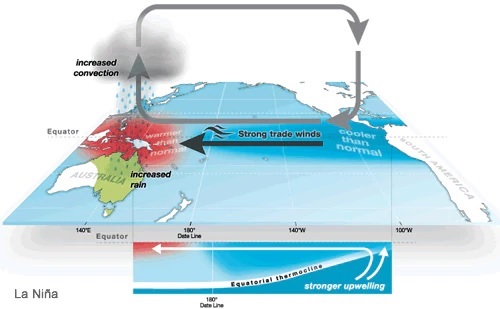La Nina
2020 NOV 5
Preliminary >
Geography > Climatology > Climatology

Why in news?
- La Nina conditions are being observed in Easter Pacific.
About La Nina:
- La Nina is a coupled ocean-atmosphere phenomenon in the Pacific Ocean .
- During a period of La Niña, the sea surface temperature across the equatorial Eastern Central Pacific Ocean will be lower than normal by 3 to 5 °C.
- An appearance of La Niña persists for at least five months.
- It has extensive effects on the weather across the globe, particularly in North America, even affecting the Atlantic and Pacific hurricane seasons, in which more tropical cyclones occur in the Atlantic basin due to low wind shear and warmer sea surface temperatures, while reducing tropical cyclogenesis in the Pacific Ocean.
- La Nina is thought to cause drought in the South American countries of Peru and Ecuador, heavy floods in Australia, high temperatures in Western Pacific, Indian Ocean, off the Somalian coast and a comparatively better south west monsoon rains in India
Why does it happen?
- La Niña is a complex weather pattern that occurs every few years, as a result of variations in ocean temperatures in the Equatorial Pacific.
- It occurs as strong winds blow warm water at the ocean’s surface from South America across the Pacific Ocean towards Indonesia.
- As this warm water moves west, cold water from the deep sea rises to the surface near South America
- La Nina, along with El Nino is part of the broader El Niño–Southern Oscillation (ENSO) climate pattern.
El Niño–Southern Oscillation (ENSO)
- El Niño–Southern Oscillation (ENSO) is an irregularly periodic variation in winds and sea surface temperatures over the tropical eastern Pacific Ocean, affecting the climate of much of the tropics and subtropics. The warming phase of the sea temperature is known as El Niño and the cooling phase as La Niña.
PRELIMS QUESTION
Which of the following factors can affect Indian monsoon?
1.El Nino conditions in South America
2.Patterns in Upper Air jet streams
3.Heating of Tibetan Plateau
4.Position of Intertropical Convergence Zone (ITCZ)
Select the correct answer using the code given below:
(a)1 and 3 only
(b)1, 2 and 4 only
(c)2,3 and 4 only
(d)1,2,3 and 4
Answer to prelims question
